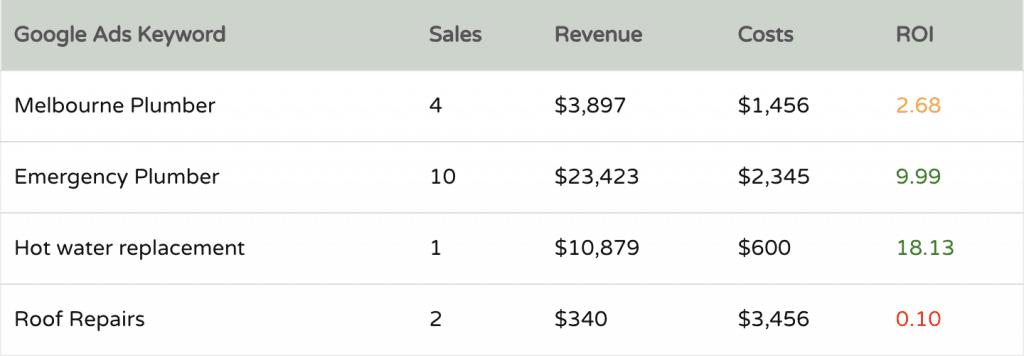“You’ve lost that loving feeling, oh that loving feeling… you’ve lost that loving feeling now it’s gone, gone… wooaaahhh”
We’ve all seen the movie Top Gun where Maverick is being backed up by his wingman Goose trying to win a $20 bet! And just like Maverick, it’s amazing how as business owners we often get that same sinking feeling when we know certain components of our business aren’t performing as well as they could (and should), but we can’t pinpoint exactly what needs to change, or why. We’ve lost that (in control) feeling!
Consider this article your wingman. We’ll help you get on top of your game by giving you the run down on all the sales and marketing metrics you should be tracking in order to identify precisely what is and isn’t working for your business. This is the fundamental starting point for getting better results, growing your business and most importantly, how to sustainably grow revenue in your business.
How often do you get that “NFI” feeling? As in…
- The sales team aren’t performing as well as they should, but can’t pinpoint why
- We know some of our marketing is working, and some isn’t, but can’t tell you exactly which parts
- My team can’t provide the data to show where things are falling down
- Why is Jim converting more leads than Jane
- I can’t tell you how much revenue I made from AdWords last month
- I know we are leaving revenue on the table, but I don’t know where to start
Turn Feelings into Power…
The simple reason you get these ‘feelings’ is that you don’t have the right tracking and reporting framework (often referred to as analytics) in place. Once you’ve spent a bit of time (and money, unfortunately) setting up this framework properly, you’ll capture the right data that will provide the information and answers you need, therefore giving you the power to start optimising and improving and steer your ship on to greater things!
What 15 Years in Business Has Taught Me
Let’s face it, every business owner that ever walked the planet would like to see their businesses make a tonne of cash. Believe me though, it won’t happen unless you have this tracking and reporting framework in place. It’s vital for business growth because:
- It’s how you better manage sales and marketing (customer acquisition channels)
- It pinpoints where things are falling down
- It’s the most effective way to maximise ROI
The 4 Most Important Metrics for all Businesses
Over the past 15 years, we’ve been running our own businesses (both super successful and miserable failures) and have acquired a hell of a lot of knowledge and insights from our own experiences that allows us to define the key ingredients to success.
The Outcome: LTSPG
Long Term Sustainable Profitable Growth of your business, with better marketing and more effective sales! Simple outcome, but a little bit more complex to deliver. So let’s jump in:
The top 4 sales and marketing metrics are:
- Revenue by Marketing Source/Channel
- Cost per Acquisition
- Sales Pipeline
- Sales Activity
1. Revenue by Marketing Source/Channel
The first step is to be clear on how much revenue each marketing channel is producing. This quickly identifies where we are getting good ROI on our marketing spend versus where we are pissing money up against a wall.
High Level
So we want to start with a high level report on revenue by channel. A sample report might look like this:

Yellow pages, really – who the hell advertises in yellow pages!!!
But the devil is in the detail
Next we need to dig a little deeper – it’s not good enough to just go we made $35,6780 in revenue from our AdWords. We need to go to the campaign level and then to the specific client engagement that produced that. So a sample report might look like:

You can see here how we start to get a complete picture of all marketing and what is adding real value to our business, what is driving revenue and what isn’t!
And today it is all trackable!
That’s right, today we can now track (within reason) every single interaction that a person has with your business (still some gaps in retail).
Check out our recent “cool technology post” which explains how you can have near-complete tracking of revenue by marketing source.
Lifetime Value (LTV) by marketing channel
One of the by-products of this process is that you can now clearly calculate the lifetime value of a client by marketing channel, and therefore how much you are prepared to pay per acquisition (this is really important; more about this later)
2. Cost per Acquisition
The second piece to the puzzle is a clear understanding of the cost to acquire a client. Once we know what it is costing us to acquire a client, we can determine how profitable they are to the business. This gives us two core bits of information:
- What are we prepared to pay to acquire a new client
- Let’s us get as many as we can at that price
Once again, technology reigns king!
Technology now allows us to pass all cost data into the right analytics framework, so that we can generate reports that provide clear ROI calculations.
High Level
So we want to start with a high level report on revenue by channel. A sample report might look like this:

Go hell for leather!
So you can start to see the good the bad and the ugly! The green looks great, let’s go hell for leather on doing more of those because they are highly profitable for us.
Stop!!!
Equally important to any business is to stop doing things that aren’t giving you the return. Red clearly highlights where we are blowing money away and there is no way for us to improve.
The fence sitter!
So AdWords is working for us with an ROI of 3.7 times, so let’s see what’s working for us and what’s not:

Same again, please!
Once again, let’s go hell for leather on the green, but let’s cut costs on the orange to get a better ROI, and let’s pause the red.
Doubled ROI overnight!
We’ve literally doubled the ROI we get from AdWords overnight, simply by knowing what is working and what isn’t.
A word of wisdom
People are a real cost in your marketing. So if somebody is spending 1 day a week creating content/social/email you need to add this in as a real cost. And you actually need to double the cost. So if their wage is $300 per day, you need to put in $600 per day (that’s what they will cost your business when you take into account things like leave, entitlements, fixed costs and payroll tax).
3. Sales Pipeline (aka Effectiveness)
SALES
The second half of the revenue equation is sales, which you may not want to hear but the fact is it’s still a vital aspect of your business. Getting your marketing pumping so that you’re attracting the right prospects is the first half of the equation. The second half is converting those prospects into $$$$.
The effectiveness of your sales team is determined by two core factors:
- Activity – how many times each rep undertakes a sales activity
- Effectiveness – how effective each rep is in moving potential clients through the sales process (or as we like to call it, sales pipeline)
A little equation that you need to become familiar with:
Sales Success = Sales Activity * Sales Effectiveness
How effective we are at moving a lead/person through the sales pipeline determines our conversion rates, and ultimately how good we are at closing sales. This is all about how well we are engaging and connecting with our prospects and getting them to the next step in the sales process.
It starts with a well-defined sales process:
The starting point is to ensure we have a well-defined sales process that all sales reps are following. This allows us to start to pinpoint how effective each sales rep is at each step. Thus we can determine exactly where each rep can improve:
Example of sales pipeline

It just jumps out at you, Bruce can’t close!
Straight away we can start to see some glaringly obvious things that we can start to address with quick wins. In this case, Bruce needs to work on his closing and follow up skills, so let’s get onto some staff development and training to help him along.
As for Bill, he has trouble qualifying and booking meetings
He’s struggling to book meetings. And with a bit of exploring this with Bill you quickly discover that Bill isn’t very good at building rapport on that first phone call, so it’s time to revisit this part of the sales process.
The old meeting rhythm
Sales managers and reps need to get into a regular meeting rhythm of seeing where their pipeline is at, where things are falling down and what can we do every day to get better and better.
Daily review
- How can we close sales today
- How can we get what leads to the next level today
- How can we get more leads into the top of the funnel
Weekly
- How did we go last week
- What’s this week looking like
- Big fish to get across the line
Monthly
- Past month
- This month
- Where are things breaking down
Dashboards / Reports are your best friend
The beauty of technology is that these are all now fully automated and easy to set up. So that by the click of a button each sales rep and the sales manager can see exactly what each person is in the pipeline and where things are being missed.
Accurate sales forecasts
One of the benefits of this is that it allows accurate sales forecasts. You can tell at a glance are we up, are we down or are we on track. Within reason, you should know what sales are going to look like next week, the week after, next month, just by looking at where you are today. And of course you can adjust course accordingly as necessary.
4. Sales Activity
The second piece to the sales game is to track and report on activity – basically the volume of work your sales reps are undertaking. This includes:
- How many phone calls are being made (Inbound & Outbound)
- How long do they spend on the phone
- How many people walked through the door
- How many sales meetings did they have
- How many items did they sell
What employing over 300 sales reps has taught me
My experience in employing large numbers of sales reps is that like most humans, they will choose the path of least resistance (it’s human nature). That’s why it’s so important to track their activity so that you can ensure activity levels meet your expectations and step in where necessary.
Not another equation?!
Daily + Daily + daily + daily +daily = Weekly + weekly + weekly + weekly = Monthly…
You get the gist. So this is all about daily tracking and making sure each and every sales rep does exactly what they should.
Automated reports! By setting up automated reports and dashboards you’re going to make your life so much easier.
9am tomorrow morning. You can see in 3 seconds that Bruce had a cracking day yesterday being 120% up on his calls whilst Bill was down 50%! This gives you the ammunition to go, “Bill what the hell happened?”
4 Metrics to get back that loving feeling
Now that we’ve reached the end of our metrics discovery journey, we hope you feel informed and enlightened to the benefits of tracking and reporting on our 4 essential sales and marketing metrics, which will change the way you look at and run your business.

As Maverick said, “I feel the need, the need for speed!”








